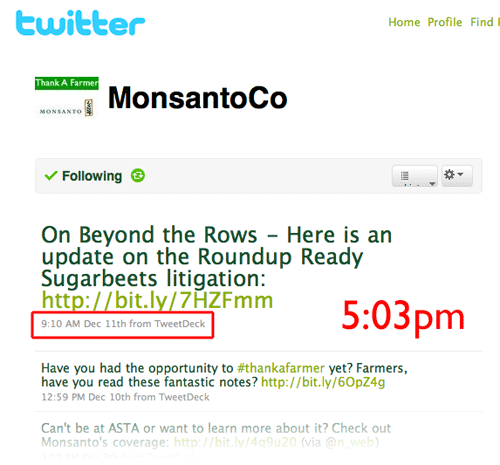I just spotted (in Google Reader) an Associated Press story about Monsanto with the headline: Monsanto seed business role revealed. Here’s the first graph:
ST. LOUIS — Confidential contracts detailing Monsanto Co.’s business practices reveal how the world’s biggest seed developer is squeezing competitors, controlling smaller seed companies and protecting its dominance over the multibillion-dollar market for genetically altered crops, an Associated Press investigation has found.
I was curious what the twitterverse was saying about the story and found an endless stream of links and comments. No surprise there.
I’ve been following one of Monsanto’s Twitter feeds (@monsantoco) for a while and dropped into see how they were responding to the story and the Twitter buzz.
Nothing since Friday morning at 9:10. Hard to draw any conclusions without know more but with almost 3,000 followers, why wouldn’t you use Twitter to “engage in the conversation.” If not now, when? If not Twitter, how? If you’re going to use social media to tell your story, you gotta be there if/when the story gets unpleasant or be conspicuous by your absence.
Depending on the serious of the AP investigation, there are probably lots of emails and phone calls and maybe even a few meetings, to decide if/how/where to respond to the story.
If anyone on Learfield’s senior management team are reading this, take a few minutes at your next meeting to talk about how you would respond to a big, negative story about our company. I really think we could engage quickly without making our lawyers all jittery and nauseous.
Disclosure: Monsanto is an advertiser on at least one of the radio networks owned by the company I work for.
UPDATE: Monsanto did get a response up last night. And linked to it from Twitter. Probably hard for a company that large to move any faster.

